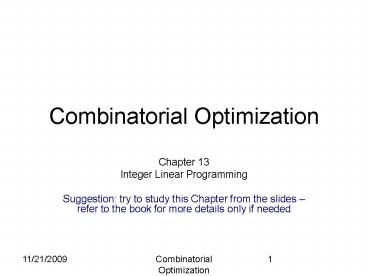Combinatorial Optimization - PowerPoint PPT Presentation
1 / 17
Title:
Combinatorial Optimization
Description:
Suggestion: try to study this Chapter from the s refer to the book for ... Sometimes variables are tricks' to make the model be correct ... – PowerPoint PPT presentation
Number of Views:50
Avg rating:3.0/5.0
Title: Combinatorial Optimization
1
Combinatorial Optimization
- Chapter 13
- Integer Linear Programming
- Suggestion try to study this Chapter from the
slides refer to the book for more details only
if needed
2
Integer Linear Programming
- min c x
- s.t. Ax b
- x 0
- x integer
3
Polyhedral representation
Problem Vertices of the polytope are not
necessariliy integral points
4
Polyhedral representation (2)
Solution choosing nearest integer point May be
infeasible
5
Polyhedral representation (3)
In fact the whole problem might be infeasible
assessing feasibility is already a difficult task
6
Other reasons against rounding
- Sometimes variables are tricks to make the
model be correct - Sometimes variables naturally express integral
entities
7
Example 13.1 Modelling TSP
- min Si,j i?j cij xij
- s.t. Sj xij 1 for all i
- Si xij 1 for all j
- 0 x 1
- Si e S je,V\S xij 1 for every S subset
of V - xij integer
Exponential number of constraints
8
Example 13.2 (cont.)
- min Si,j i?j cij xij
- s.t. Sj cij xij 1 for all i
- Si cij xij 1 for all j
- 0 x 1
- ui uj nxij n-1
- xij integer
- ui 0 for all i
9
Correctness
- Let p be a solution to TSP, that is a cyclical
permutation of the cities, then we let ui t if
p(t)i. Now, consider the t-th arc in the tour,
then we set xij 1, uit-1 and ujt. It then
holds that ui uj nxij -1 n n-1 as
required. Moreover, if xij 0, the equation is
always satisfied by the ui variables. Now we show
that every feasible solution is a tour. - Suppose not, left as an exercise...
10
Example 13.2 Satisfiability
- Boolean variables x1, x2,...,xn.
- Literal ?i xi, or xi ( where xi true if
xi is false and vice versa). - Disjunctive Clause Cj (?i or ?k or ?l ... ?z)
(or ) - Conjunction of Clauses (Cj and Cp and ... and
Cm) - (and )
- Satisfiability Given a boolean expression which
is a conjunction of disjunctive clauses, is there
a thruth assignment for the literatal which makes
the boolean expression true?
11
ILP for Satisfiability
- SAT (x1 x2 x3 ) (x1 x2 ) (x2 x3)
(x3 x1) ( x1 x2 x3). - ?
- ILP
- x1 x2 x3 1
- x1 (1- x2) 1
- x2 (1-x3) 1
- (1-x1) x3 1
- (1-x1) (1-x2) (1-x3) 1
- 0 x1 x2 x3 1
- x1 x2 x3 integer
SAT has truth assignment if ILP has a feasible
solution!
12
Total Unimodularity
- Definition 13.1 A square integer Matrix B is
called unimodular (UM) if its determinant det(B)
1 or det(B) -1. An integer Matrix A is called
totally unimodular (TUM) if every square
nonsingular submatrix of A is UM.
13
LP in standard form and TUM
- Let polytope R1(A) be defined as
- Ax b
- x 0
- Theorem 13.1 If A is TUM, then all vertices of
R1(A) are integer for any integer vector b. - Skip the proof!
14
LP in canonical form and TUM
- Let polytope R2(A) be defined as
- Ax b
- x 0
- Theorem 13.2 If A is TUM, then all vertices of
R2(A) are integer for any integer vector b. - Skip the proof!
15
Applications of TUM
- Theorem 13.3 An integer matrix A with
- aij -1,0,1 is TUM if no more than two nonzero
entries appear in any column, and if the rows of
A can be partitioned into two sets I1 and I2 such
that - If a column has two entries of the same sign,
their rows are in different sets - If a column has two entries of different signs,
their rows are in the same set.
16
Rest of chapter
- Skip 13.3
17
Exercises
- Slide 9.
- Show that if there exists a polynomial algorithm
for ILP, then there exists a polynomial algorithm
for SAT. - Is the LP for shortest path TUM? Motivate your
answer - Same as under 3 for Max Flow?































